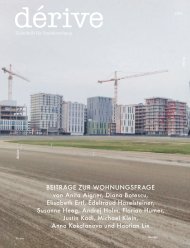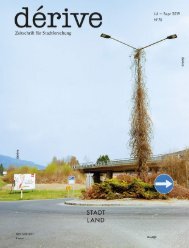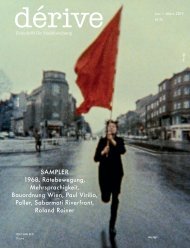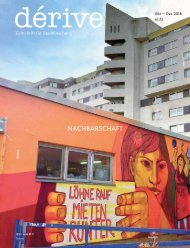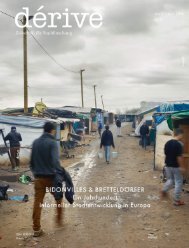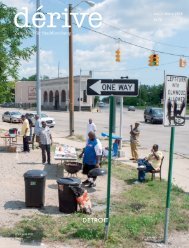Warsaw: Devastation, Modernization, (Re-)privatization, dérive - Zeitschrift für Stadtforschung, Heft 72 (3/2018)
Warsaw is a city that has experienced radical breaks in its development over the last century, which are still relevant and visible in many different ways today. There is the Nazi occupation, the crushing of the Warsaw Ghetto Uprising and the subsequent systematic and almost complete destruction of the city; and more recently, the shift from a state-socialist to capitalist system. The new issue of dérive, entitled »Warsaw: Devastation, Modernization, (Re-)privatization«, sheds light both on these historical components and their impact on contemporary urban society – e.g. on the housing market. In addition, we talk to people who are self-organizing and working on alternative solutions that resist current socio-political conditions. The focal point is entirely in English. You can order it here: https://shop.derive.at/collections/einzelpublikationen/products/heft-72
Warsaw is a city that has experienced radical breaks in its development over the last century, which are still relevant and visible in many different ways today. There is the Nazi occupation, the crushing of the Warsaw Ghetto Uprising and the subsequent systematic and almost complete destruction of the city; and more recently, the shift from a state-socialist to capitalist system. The new issue of dérive, entitled »Warsaw: Devastation, Modernization, (Re-)privatization«, sheds light both on these historical components and their impact on contemporary urban society – e.g. on the housing market. In addition, we talk to people who are self-organizing and working on alternative solutions that resist current socio-political conditions. The focal point is entirely in English. You can order it here: https://shop.derive.at/collections/einzelpublikationen/products/heft-72
Create successful ePaper yourself
Turn your PDF publications into a flip-book with our unique Google optimized e-Paper software.
Kunstinsert / Artistic Insert<br />
Joanna Rajkowska<br />
Trees and Stumps<br />
Joanna Rajkowska works in and with the public space, which she perceives as a highly political<br />
place where different forms of life meet. In 2002 she realized her most famous project in <strong>Warsaw</strong><br />
– Greetings from Jerusalem Avenue. On her own initiative and inspired by a trip to Israel, she set<br />
up the 15-metre-high artificial palm tree on one of the city’s main roads, the Alej Jerozolimskich.<br />
It still stands there as an exotic foreign body that has become a point of identification and<br />
orientation in the city. Rajkowska selected two photos for <strong>dérive</strong> showing how the tree is cared for<br />
(again and again, the tree has to be provided with new bark), and related these to a current work<br />
of hers that constitutes a monument to the deforestation of Polish primeval forests. She writes<br />
about the photos:<br />
1) This is the date palm tree bark that we use to cover the trunk of the artificial palm tree in<br />
<strong>Warsaw</strong> (Greetings from Jerusalem Avenue, 2002), the brightest and most joyful project of all my<br />
public works. It refers to the multicultural city that <strong>Warsaw</strong> once was, to its unbelievable vibe<br />
and energy.<br />
The bark is very expensive and we usually buy it in the United States. So we try to keep<br />
some of it spare and even recycle it sometimes. In 2014 we decided to spread the new bark on the<br />
roof of one of the buildings of the Museum of Modern Art in <strong>Warsaw</strong>, allowing it to weather<br />
and better match the old bark. It was damn cold on that day but I really wanted to capture the wild<br />
look of it against the <strong>Warsaw</strong> cityscape. It was magic but my fingers got completely frozen and I<br />
only regained the feeling in the tips of my fingers months later.<br />
2) This is the trunk of the palm tree itself, under reconstruction. It is important to keep it looking<br />
alive. Apparently it is an important point of reference for many visitors, newcomers and refugees<br />
in <strong>Warsaw</strong>. They say it makes them feel at home. The palm tree is 15 meters high (including the<br />
crown), so we need scaffolding to do anything. Years ago, when the weather was good, we would<br />
usually have a couple of bottles of beer in secret, right under the palm tree leaves, high up. It was<br />
great and I remember the sensation of having real power over Jerusalem Avenue down below.<br />
Now, the regulations are so strict that we can’t do this any more. :(<br />
3) Times are very different now in comparison to 2002, when Greetings from Jerusalem Avenue<br />
came to life. This project (I shall not enter into your heaven, 2017) is a cry of desperation. It<br />
points to an uprooting, a cutting off, or a wrenching. I created a wall of 22 tree roots stacked in<br />
six columns. Not only is the right-wing government logging the ancient primeval forests in Poland,<br />
but we, as humans and citizens, are also going through a period of extensive uprooting. It is<br />
such a paradox that the more they are trying to root society in the national soil, the more uprooted<br />
I feel. It is reckless and painful.<br />
Joanna Rajkowski’s exhibition Suiciders at the TRAFO Centre for Contemporary Art in Szczeczin<br />
(http://trafo.art) has just come to an end and is to be followed by a solo exhibition at l’étrangère in<br />
London in September and the Qalandiya International Biennale in Ramallah from 3 October <strong>2018</strong>.<br />
rajkowska.com<br />
Andreas Fogarasi<br />
Joanna Rajkowska — Kunstinsert<br />
37









